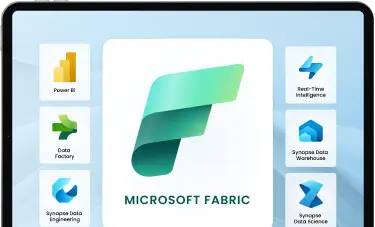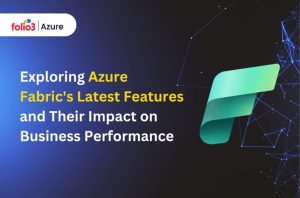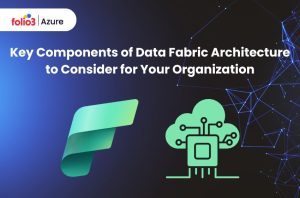Table of Contents
ToggleDid you know that almost 90% of businesses manage their data on multiple cloud platforms? However, organizing and integrating this data is daunting for many businesses. With Microsoft Fabric, you can bring your cloud data into one combined system, simplify data management, and gain valuable insights.
Connecting external cloud data sources to Microsoft Fabric will simplify and organize your operations and lay a powerful foundation for real-time data analysis and growth.
This article will explore how Microsoft Fabric’s key features and best practices make it the best choice for cloud data integration and how it enables you to manage external cloud data sources securely and efficiently.
Accelerate smart decisions with Microsoft Fabric's unified data and AI analytics.

Key Features of Microsoft Fabric for External Cloud Connectivity
Connecting to external cloud data sources with Microsoft Fabrice provides multiple benefits. Let’s see why Microsoft Fabric is necessary for a smooth and secure cloud data integration.
1. Native Integrations with Cloud Providers
Microsoft Fabric has native connectors for famous cloud providers such as AWS, Google Cloud, and other pioneering platforms. This built-in connectivity simplifies your work, enabling you to gather and combine data from various providers into a unified system.
By integrating these external cloud data sources, Fabric rids the need for manual data extraction. Hence, this improves efficiency and leads to a smooth flow of information in your entire cloud environment.
2. Unified Data Platform
By using Microsoft Fabric, data ingestion from external cloud data sources is simplified and provides you with a cohesive data environment. This uniformity in data reduces errors and warrants that data is always reliable and ready to be used.
The unified data platform of Microsoft Fabric lets you bring together all your data sources without involving complex and multiple tools or additional platforms, thus saving your time and resources on cloud data integration.
3. Real-time Data Pipelines
Microsoft Fabric’s real-time data pipelines are its distinguishing feature. It automates the entire process of integrating data from external cloud data sources. These pipelines keep your data synchronized as it flows in from various providers.
This means you can always access the latest information without requiring manual updates. This real-time cloud data integration feature is valuable for organizations requiring immediate action based on data.
How Microsoft Fabric Handles External Cloud Data Connections
Microsoft Fabric was developed to connect with external cloud data sources simply and efficiently. Let’s examine the tools and features that support smooth and secure connections.
1. Supported Data Sources
Microsoft Fabric supports many external cloud data sources, including Azure, AWS S3, and Google Cloud Storage. This extensive support allows you to consolidate diverse cloud data sources into one ecosystem, reducing the need for custom connections.
Fabric’s ability to work seamlessly across different cloud providers means you can gather all your data in one place, removing compatibility concerns and creating an ideal setup for efficient cloud data integration.
2. Connection Setup
Connecting to external cloud data sources in Microsoft Fabric is simple and accessible. A user-friendly interface helps you set up connections with multiple cloud data sources. If you prefer API-based integration, Fabric provides strong API support to help automate connection setup.
This step-by-step connection eliminates the technical hurdles faced during cloud data integration, making it accessible to users of all skill levels.
3. Data Security & Compliance
Security and compliance are top concerns when connecting to external cloud data sources. Microsoft Fabric uses encryption and secure endpoints to protect your data, both while it is in transit and at rest.
Moreover, Fabric complies with necessary data regulations, such as GDPR, guaranteeing that your data handling always aligns with legal guidelines. This high priority given to cloud data security lets you connect external cloud data sources easily without worrying about security risks or compliance issues.
Challenges and How Microsoft Fabric Addresses Them
Connecting external cloud data sources might be complex, especially when working with different cloud providers. Microsoft Fabric provides various solutions to simplify cloud data integration and increase productivity to handle these issues.
1. Cross-cloud Data Compatibility
Data compatibility is among the most difficult challenges when working with different cloud providers. Microsoft Fabric resolves compatibility issues by providing connectors that handle data translation.
These built-in connectors let you combine data from AWS, Google Cloud, and others without needing custom configurations. They save your time and minimize errors, making cloud data integration smooth and easy.
2. Latency and Data Synchronization
Latency can be a significant problem when integrating external cloud data sources. This is because data from one provider might arrive more quickly than another. Microsoft Fabric reduces latency by using real-time synchronization tools, letting you keep your data consistent and updated across platforms.
This synchronization also warrants that time-sensitive information is available immediately, which is important for organizations that rely on real-time data to make quick and informed decisions.
3. Data Governance Across Clouds
Managing data governance across different cloud platforms can be a daunting task. Microsoft Fabric simplifies this process by providing a centralized system for applying data governance policies regardless of the data source.
With the help of Fabric’s unified governance tools, you can handle data permissions, monitor data usage, and guarantee data integrity at various external cloud data sources. This combined approach for data governance makes Fabric perfect for maintaining consistent policies and ensuring compliance across cloud providers.
Best Practices for Establishing Seamless Connections
Adhering to these best practices can help you set up a high-performance, secure, and efficient connection to external cloud data sources with Microsoft Fabric, refining your cloud data integrations.
1. Authentication Methods
Authentication is a primary concern when connecting to external cloud data sources. Microsoft Fabric provides multiple authentication options, including OAuth and service principals, to establish secure connections.
Implementing multi-factor authentication (MFA) and frequently updating access permissions are important best practices to safeguard against unauthorized access. These secure authentication methods let you build and maintain strong cloud data security, which is mandatory when handling sensitive or regulated data.
2. Data Pipeline Optimization
Optimizing data pipelines is necessary for minimizing latency and maximizing efficiency in cloud data integration. Setting up data ingestion and transformation settings can lead to fast and reliable data transfers from external cloud data sources.
Microsoft Fabric provides tools to set data transfer limits and track performance. This lets you refine pipelines for getting the best results. This attention to optimization is beneficial when working with massive datasets or frequent data updates.
3. Error Handling and Monitoring
Error handling and monitoring are other important factors for achieving smooth and uninterrupted data flows. Microsoft Fabric has comprehensive monitoring and alerting features that track your connections to external cloud data sources in real time.
Setting up notifications for interruptions or connection issues helps you handle problems proactively, minimize downtime, and maintain smooth data integration. Implementing an effective error-handling system also makes you well-prepared to respond to problems.
Conclusion
Connecting to external cloud data sources with Microsoft Fabric is a strong method of centralizing, securing, and efficiently managing your data at different cloud platforms. With features like native cloud integrations, real-time pipelines, and strong data security, Fabric was developed to manage the complexities of cloud data integration, making it a reliable choice for your data needs.
Microsoft Fabric successfully handles the challenges of cross-cloud compatibility and data synchronization and simplifies data governance, leading to a seamless experience.
Thus, if you’re ready to simplify your cloud data integration and make the most of Microsoft Fabric’s capabilities, now is the perfect time to explore Microsoft’s platform in depth. It is easy to connect external cloud data sources with Microsoft Fabric and give your data management strategy a new face today!



